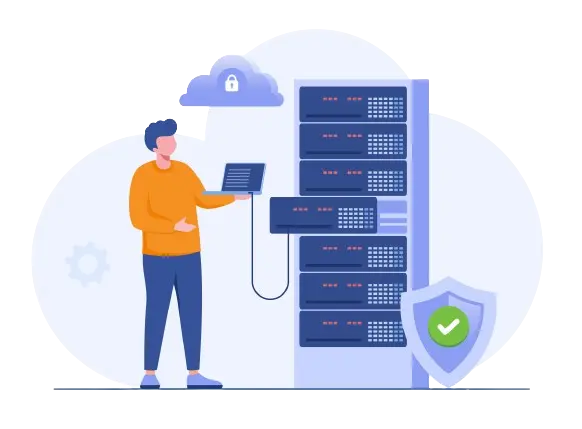One of the biggest concerns for everyone operating in the internet world is cyber attacks on their websites. Among these, DDoS (Distributed Denial of Service) attacks are some of the most common and effective. But what is a DDoS, how does it work, and how can you protect your website from such attacks? We provide a clear and explanatory guide for both those with technical knowledge and newcomers to the topic.
İçindekiler
What is DDoS?
DDoS (Distributed Denial of Service) is a type of cyber attack that aims to disrupt or completely stop the service of a website or server by sending an overwhelming amount of traffic. These attacks are usually conducted simultaneously from multiple sources, hence being “distributed”. Attackers take control of numerous devices across the internet and send data simultaneously to the target site, rendering it inoperable.
DDoS attacks create such heavy traffic to the targeted website that it cannot serve its normal users. This situation creates a serious problem, especially for sites that need to be continuously accessible like e-commerce websites.
How Does a DDoS Attack Work?
DDoS attacks are often carried out by a malicious network known as a botnet. A botnet is a group of virus-infected devices that are controlled by attackers and can receive commands. These devices can be computers, smartphones, IoT devices (smart home devices), and various other technological tools.
Attackers use these compromised devices to send massive amounts of data traffic to the target website. This intense traffic exhausts server resources, fills up bandwidth, and slows down or completely incapacitates the site.
There are several different types of DDoS attacks:
- Volume-based Attacks: These attacks send large volumes of data to flood the bandwidth of the target website, causing it to crash under the traffic load.
- Protocol Attacks: These aim to consume the server’s network communication protocols, targeting especially the TCP/IP protocols.
- Application Layer Attacks: Conducted using vulnerabilities in the application layer of the target site, these attacks focus on exhausting server resources by targeting the website’s functions.
How Can You Protect Your Website from DDoS Attacks?
Protecting against DDoS attacks requires a proactive approach. You can use the following methods and tools to safeguard your website:
1. Choose a Good Hosting Provider
Ensuring that the server hosting your website is resilient against DDoS attacks forms your first line of defense. Working with providers that offer DDoS-protected hosting services enhances the security of your site against attacks.
2. Use a DDoS Protection Service
One of the most effective ways to defend against DDoS attacks is to employ services that specialize in DDoS protection. These services identify the type of attacks your site is facing and filter the traffic to block the attack. Major DDoS protection services like Cloudflare, Akamai, AWS Shield are popular in this field.
3. Utilize a Load Balancer
A load balancer distributes incoming traffic across multiple servers, preventing system overload. This helps distribute the heavy traffic caused by DDoS attacks and prevents system collapse.
4. Implement a Web Application Firewall (WAF)
A WAF analyzes traffic coming to your website and filters out requests from attackers. Using a Web Application Firewall (WAF), you can stop malicious traffic targeting your site and thwart DDoS attacks.
5. Use a CDN (Content Delivery Network)
A CDN distributes your website’s content across servers worldwide, serving users from the nearest server. This not only increases your page load speed but also spreads the load during a potential DDoS attack across various servers.
6. Employ Traffic Monitoring and Analysis Tools
DDoS attacks are often detected due to sudden spikes in traffic. By using traffic monitoring tools, you can detect abnormal traffic and take preventative measures against potential attacks. Tools like Nagios, Zabbix, SolarWinds are frequently used in this area.
7. Prepare an Emergency Plan
Considering that a DDoS attack can happen at any time, preparing an emergency plan minimizes your losses in case of an attack. This plan should include the steps to be taken and the tools to be used. Ensure that your team is familiar with this plan and can act quickly when necessary.
Effects of DDoS Attacks
DDoS attacks not only slow down or make your website inaccessible but can also lead to financial losses. Service interruptions for e-commerce sites mean significant customer and revenue losses. Additionally, the success of an attack can negatively impact your brand’s reputation.
Another critical issue is that DDoS attacks can set the stage for other cyber attacks. While distracting you with DDoS, attackers can simultaneously target other vulnerabilities.
Conclusion
DDoS attacks are among the most dangerous threats encountered in the internet world. However, you can defend against these attacks by taking the right measures and securing your website. Steps such as using a good hosting provider, DDoS protection services, load balancers, and WAF play a significant role in enhancing your site’s security. Additionally, continual traffic monitoring and having an emergency plan ready can prepare you for attacks.
Securing your website not only protects against attacks but also offers a better experience for your users. Therefore, adopting a proactive approach and strengthening security measures will always protect your site.






